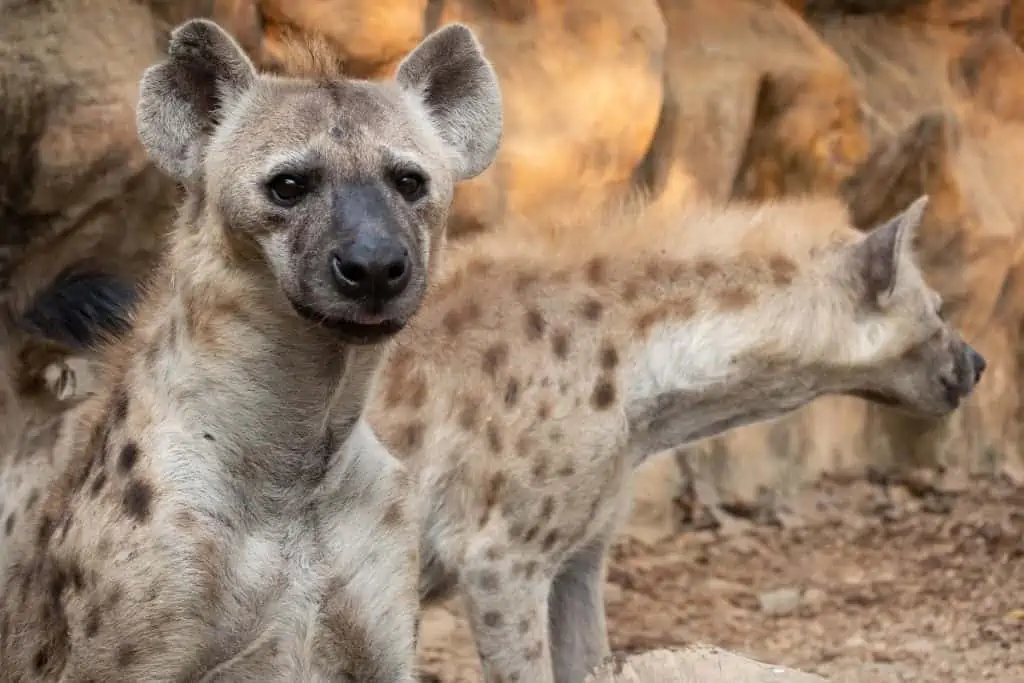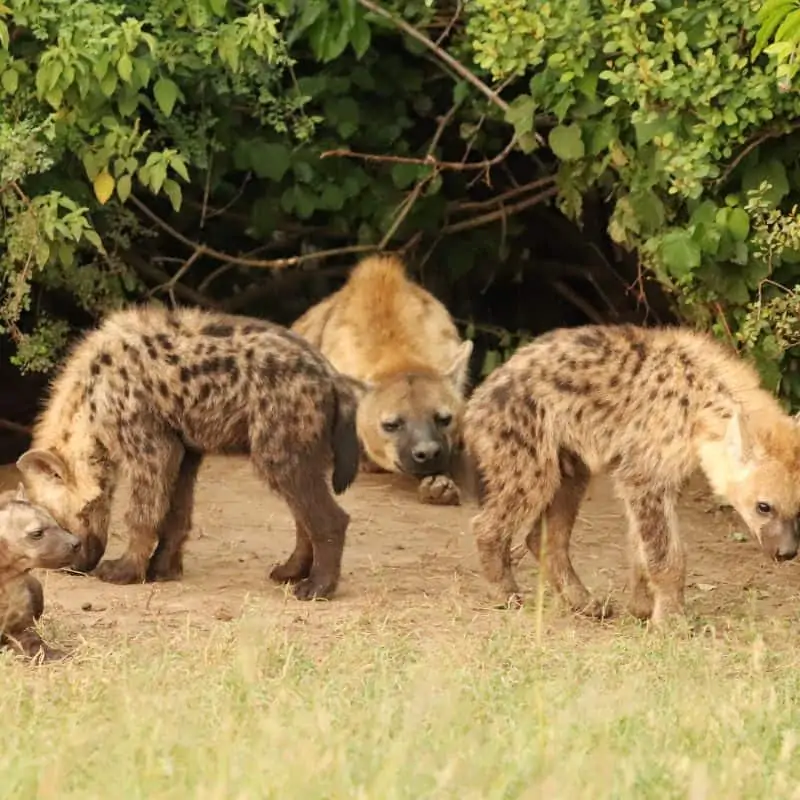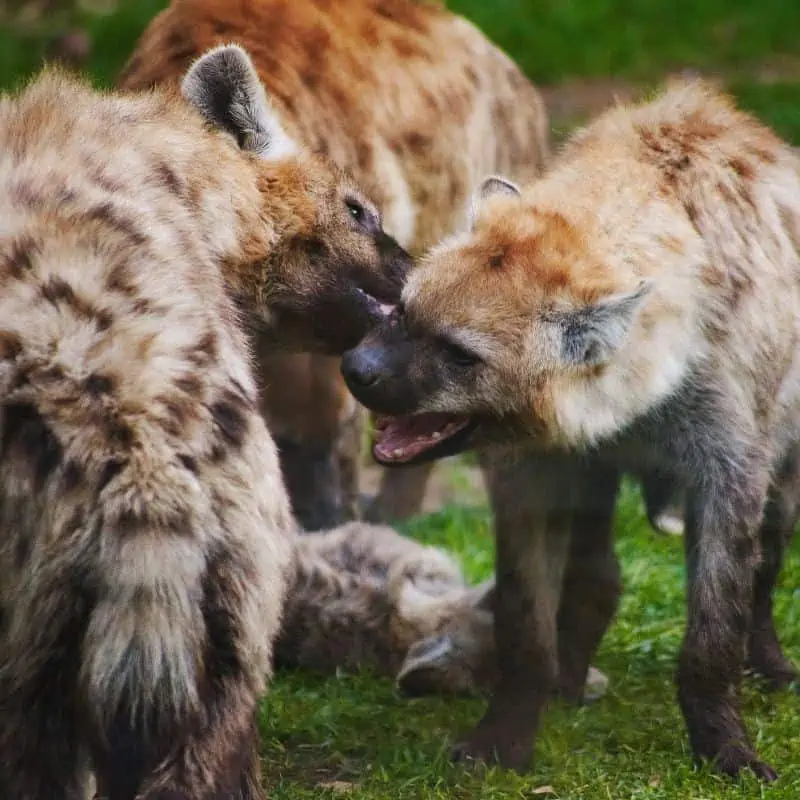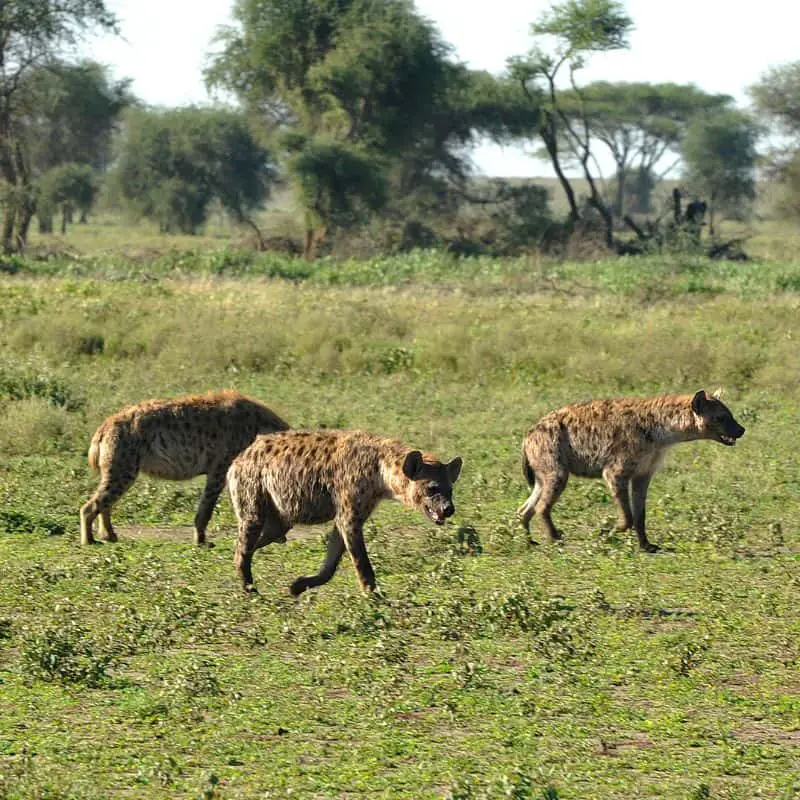Hyenas can often be seen roaming in packs and scavenging for food. But just how many hyenas makeup one of these groups? What is a group of hyenas called exactly?
Hyenas live in groups called clans or packs (or a “cackle” or “laughter”). These groups are composed of related females and their cubs. Males may join occasionally, but hyena societies are matriarchal, with the female at the top of the hierarchy making most decisions. Cackles provide safety, support, and better hunting success for hyenas, and they use loud calls to communicate from long distances.
In this article, we will examine why hyena groups are called what they are and the importance of these groups to their survival.

What Is a Group of Hyenas Called?
A group of hyenas is referred to as a cackle or clan. This term is most commonly used for spotted, brown, and striped hyenas.
The fourth hyena species, the aardwolf, is mostly a solitary animal.
The clan size of hyenas can range from 2 to 80 members and generally includes related females and their cubs, as well as a few unrelated males.
The social structure within a clan is highly organized, with an alpha female at the top of the hierarchy.
A clan will hunt and feed together, but females typically dominate males in social situations.
How Do They Form Groups?
Hyenas form clans by establishing a hierarchy of dominant and subordinate individuals. They determine this ranking through:
- Physical displays
- Vocalizations
- Scent marking
The alpha female is usually the most dominant of the group and will challenge any animal that tries to challenge her authority.
She also controls access to food sources, mating partners, and safe places to sleep.
The clan members will work together to raise and protect their young, forage for food, and defend their territory.

What Are the Benefits of Forming Groups?
Hyenas are social creatures that believe in strength by numbers.
Their groups help them in different ways and have a lot of benefits. Let’s explore these benefits.
1. Increased Protection
Forming groups provide increased protection for hyenas. Having a larger group of individuals to defend their territory and food sources from predators makes it more difficult for a predator to single out an individual.
The presence of related females helps ensure that cubs are raised successfully, as they can rely on their mothers and other female relatives for help in caring for the young.
2. Increased Hunting Efficiency
A group of hyenas also improve their hunting. By working together, they can take down larger prey than they can on their own.
Additionally, having multiple individuals when chasing a large animal helps ensure that the prey cannot escape very easily.
Groups help hyenas to spot potential predators more quickly, allowing them to take defensive action before they are in danger.
3. Greater Access to Resources
Having a larger group of hyenas also provides greater access to resources such as food and water.
With multiple individuals searching for food sources, they are more likely to find something that suits their needs.
Working together can cover more ground in less time to find the best available resources.

4. Increased Mating Opportunities.
Being in a group also gives hyenas greater access to potential mates. As the alpha female is usually the most dominant in the group, she will have the first pick of potential partners.
Group living also provides more opportunities for cubs to find suitable mates when they become adults.
5. Social Bonds
Forming groups also helps hyenas to form strong social bonds with one another.
Having members of the clan living together in close quarters helps them to develop relationships, improve communication and understanding, cooperate more effectively, and build a supportive family structure.

How Hyena Social Structures Differ From Other Animals
Hyenas’ social structures are unique in a number of ways.
Hyena clans are matriarchal, and females tend to be more dominant than males. This is different from most other animals, which typically have a male-dominated hierarchy.
They form coalitions with one another based on relatedness and status rather than forming alliances based on individual strength or power.
This type of social structure helps them to maintain their hierarchical dominance.
How Do They Work in Groups?
Hyenas work together in complex social structures that are organized hierarchically. The structure of the hyena clan is determined by a dominance hierarchy within each sex, with subordinate individuals deferring to dominant individuals.
Dominance is established through aggressive interactions between members of the same sex. Within a clan, females tend to outrank males, and dominant females will often lead the group.
Hyenas communicate with each other in a variety of ways, including vocalizations such as whooping, laughing, and moaning.
These calls can be used to warn of danger or to advertise their presence when they are looking for food.
Hyenas also use scent marking, which is done by rubbing their heads and bodies on objects, such as trees or rocks. These scent marks are used to communicate with other members of their species.
What Type of Hunting Behaviors Do Hyenas Display in Groups?
Hyenas display a variety of cooperative and coordinated behaviors when hunting as a group. Hyena packs are highly organized and use strategies to increase their chances of success, such as surrounding or encircling their prey.
Hyena packs also work together to drive prey into hidden areas of the environment, such as thickets or riverbeds.
Groups usually start their hunt by emitting loud calls and yelps, which can be heard from miles away.
These vocalizations are used to coordinate with other pack members so that they can all move in for the kill at once.
The hyenas also use several other hunting tactics, such as herding, cornering, and chasing. By working together, hyenas can take down much larger prey than they could alone.
Final Thoughts Groups Of Hyenas
A group of hyenas is called a cackle, laughter, or more commonly, a clan or a pack. These clans are related individuals who live nearby and cooperate for mutual benefit.
These groups can be small, consisting of just a few members, or large, containing dozens of animals.
Hyena clans are highly organized and complex social structures, including a dominant hierarchy, cooperative hunting strategies, and long-lasting pair bonds between mates.
By living in groups, hyenas can survive more effectively than they would on their own. Hyena clans exemplify the power of cooperation and social interaction in the animal kingdom.
